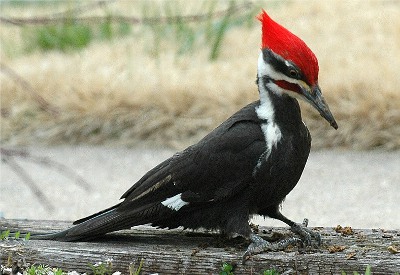Pileated Woodpecker
Category: Woodpeckers

Facts about Pileated Woodpeckers, "Scientific name for Pileated Woodpecker is Dryocopus pileatus". Pileated Woodpeckers are a Dryocopus type of bird. Pileated Woodpeckers are birds in the Class of "Aves". "Scientific name for Woodpecker is Picidae".
The Pileated Woodpeckers are native to North America, and the Pileated Woodpecker are an extremely large woodpecker in the country. The Pileated Woodpecker body size is approximately equal to that of a crow, and they live in the deciduous forests in the eastern parts of North America, the boreal forests of Canada, the Great Lakes, and some areas of the Pacific coast. The Pileated Woodpecker is also the biggest and the most outstanding forest birds in the country.
Features
The Pileated Woodpecker is fairly a big bird, with a body length, ranging from 15 45.64 inches to 19 19/64 inches (39.8 to 49 cm), with the wingspan that ranges from 26 inches to 29 1/2 inches (66 to 74.9 cm). The Pileated Woodpecker have a body mass that ranges from 8.8 pounds to 12.3 pounds (4 to 5.5 kg).
An average woodpecker's tongue is up to 4 inches (10.16 cm) long. The length can be a little different depending on which species of woodpecker. Its tongue wraps around the reinforced skull structured and squashy bone, to even out the impact of the pecking force. Pileated Woodpeckers have barbed tongues that helps them remove bugs from holes and tree bark.
Feathers that look like hairs on the Pileated Woodpecker nostrils, prevent ingestion of wood particles.
The Pileated Woodpecker has a black color body, with bold white lines down the neck and a blazing-red crest. The Pileated Woodpeckers used to whack at lifeless trees and fallen logs looking for their major prey, such as carpenter ants, leaving distinctive rectangular openings in the wood. The nest holes that the Pileated Woodpeckers make offer essential shelter to several bird varieties, including owls, swifts, ducks, pine martens and bats.
The Pileated Woodpecker appears with an elongated neck and a triangular-shaped crest that brushes off the rear part of its head. The Pileated Woodpecker have a long bill, which is in the shape of a chisel, about their head length. During the flight, the wings of these woodpeckers are wide and they resemble a crow.
Pileated Woodpeckers have zygodactyl feet, having 4 fingers, which means they have two toes facing the front and two toes facing the back, that helps them to have a strong grip on trees vertically. The Pileated Woodpecker use these 8 fingers with their stiff central portion tail feathers to brace on trees as they climb.
The male Pileated Woodpecker has a red line on the cheek. During the flight, the woodpecker discloses wide white-colored underwings and little white-colored crescents on the upper side, at the bottoms of the primaries.
The Pileated Woodpecker drills distinct holes in the shape of a rectangle in decayed wood to acquire carpenter ants and other pests. The Pileated Woodpecker are noisy birds by whinnying calls. They as well, drum on the lifeless trees in a profound, sluggish, rolling pattern, and even the deep chopping noise of foraging carries well. The flight of the Pileated Woodpeckers undulates similar to other woodpeckers, which assists to separate them from a straight flight trail of a crow.
Diet
Usually, Pileated Woodpeckers feed on carpenter ants, including other ants, termites, wood-boring beetle larvae and other insects, such as the spruce budworm, flies, caterpillars, grasshoppers and cockroaches. The Pileated Woodpecker also feed on wild nuts and fruits.
Pileated Woodpeckers possess a protective ocular mechanisms for protecting its eyes from shaking from the pecking impact. Pileated Woodpeckers show a restricted axial globe movement due to the tight fit within the fascial tissue connections and orbit between the sclera and orbital rim.
The eyes of the Pileated Woodpecker are covered with a nictitating membrane (from Latin nictare, to blink)— a translucent and transparent third eyelid - that protects the Pileated Woodpeckers eyes from flying debris while pecking.
There are more than 190 species of woodpeckers worldwide, but none of them are found in polar regions, Madagascar, New Zealand or Australia.
Male and female Pileated Woodpeckers are able to drum hollow trees logs execrate. Since Pileated Woodpeckers do not have vocal cords and don't sing, this pecking activity also plays an important role in communicating with each other. Pileated Woodpeckers drumming is also to attract a mate, mark out territory, both sexes are known to drum.
When feeding, drumming and building a nest cavity, a Pileated Woodpecker can peck up to 20 times per second, wow that's fast! or a total between 9,000 and 12,000 pecks in a day.
Pileated Woodpeckers have a prominent surge in flight comprise of three rapid wing flaps, followed by a quick glide when the Pileated Woodpeckers wings are tucked against its body rather than spread out like many other birds.
The average life span of a Pileated Woodpecker in the wild is 5 to 11 years, depending on the species and environment
Woodpeckers are omnivores; meaning - an animal that eats food of both animal and plant and origin.
Pileated Woodpeckers are monogamous meaning- the pair will mate for lifetime. Both male and female prepare the nest in the tree for babies and both will help feed them. The female Pileated Woodpecker will lay between 3 and 5 eggs and the incubation period will lasts 11 to 14 days. After one month of hatching, young Pileated Woodpeckers will leave the nest and venture out on there own.

 Back To Category Woodpeckers
Back To Category Woodpeckers